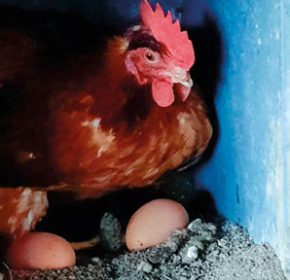Content available at: Indonesia (Indonesian) ไทย (Thai) Tiếng Việt (Vietnamese) Philipino
Despite all the handling to which our breeding hens are exposed, a percentage of the eggs will be laid on the floor of the houses.
The collection of these floor eggs is costly for the poultry farmer (Photo 1). Because they are usually dirtier, they contain more bacteria in their shells (Berrang et al., 1997) and more cracks, compared to eggs laid in nests (De Reu, 2006).
A large percentage of these cracks are the gateway for bacteria to enter the egg, resulting in lower hatchability, lower quality chicks and increased mortality in the first days on the farm (Khabisi et al., 2012).
It is commonly believed that eggs laid on the floor, if they look clean, present no problem to the hatchery.
However, Tuellett 1990; Van den Brand et al., (2016) and Meijerhof et al., (2022) reported in their studies that floor eggs even if they look clean or have been washed have a higher degree of contamination and generate a lower hatch than nest eggs.
- This percentage of minor birth is between 10% to 20%, depending on the type of bed and its condition, and can be a not insignificant figure.

The cause of such minor hatching is largely attributed to embryo death by contamination of the yolk sac, primordial around day 18 of embryonic development (Deeming et al. 2002), as some birds are unable to free themselves from the shell (Moosanezhad Khabisi et al. 2012).
It should be noted that some studies report mortality at all ages of embryonic development as can be seen in Table 1 adapted from Van den Brand et al (2016).

In addition to embryonic mortality, it is well known that in hatcheries where there are floor eggs, the number of eggs that explode increases, which generates a high bacterial load inside the machines with all the deleterious effect that this can have (Photo 2 and 3).
Chicks hatched from floor eggs, washed or not, are of lower weight when they leave the hatchers, largely due to the fact that the cracks in the shell that usually occur in this type of eggs generate a greater loss of moisture during incubation or to changes in conductance (Burton and Tullett, 1983) that cause the birds to hatch earlier than programmed and have to wait inside the hatchers suffering from dehydration.
Chicks from floor eggs have been reported to be of lower quality as assessed by percent yolk-free body mass and bird length.


Some studies show that litter in poultry houses where birds from floor eggs are housed has higher humidity and therefore birds may have more plantar dermatitis or tarsal lesions (Van den Brand et al., 2016). It is believed that this may be due to compromised in intestinal development.

WHAT TO DO WITH THE FLOOR EGG?
As can be seen in Table 1 (Van den Brand et al., 2016), washing floor eggs is not the answer to the problem. The solution is to prevent birds from getting used to laying eggs on the floor.
It is considered “normal” in heavy birds up to 2% floor eggs, higher percentages invite to review bird managements such as:
- Remember that 80% of the eggs are laid in the first 4 hours after the presence of light in the house.
- Review the number of collections, at least 5 times a day, 3 of them in the morning.
- Avoid densities higher than 5.5 birds/m2, as these add very strong competition for nest availability or
create mobility problems to have access to them.
A hand nest should be available for 3-4 birds, in mechanical nests 40 females per linear meter (Photo 4).
- Check the ratio of males to females; many males interfere with the females entering the nests.
- Locate male feeders away from the nests.
- If possible, raise the feeders after the birds ingest the feed so that they do not act as a barrier to interfere with hens’ access to the nests.
- The distance between feeders should be a minimum of 100-120 cm.

- Do not place power lines over drinkers and feeders.
- For the first three weeks of laying walk around the house 10-12 times a day, this encourages the birds to climb onto the slats. After three weeks you can reduce to 6 times, picking up the eggs from the floor and encouraging the birds not to nest on the floor. You can load the birds that are nesting on the floor and
introduce them to the nests. - Evaluate the height of the slats, this should be less than 45 cm for heavy birds and if necessary add ramps to facilitate access.
- Check the slope of the slats, this should not be greater than 5%.
Add drinkers at the level of the slats so that the birds get used to climbing them (Photo 5).

Introduce perches or platforms from day 28 of age (Photo 6).

- Age of transfer to production farms (minimum 2 weeks before) and always having all nests and equipment installed on the farm prior to arrival of the birds.
- Uniform distribution of light in the house. The appearance of dark areas invites birds to nest where they should not.
- Keep nests closed until laying begins, so that the birds associate them with laying and not with a sleeping area.
- If the nests are automatic, run the conveyor belts a couple of times every day prior to laying to get the birds
used to the noise.
In posture close the nests one hour before the light is turned off and open them 2 hours before the light is turned on, Photo 7.

Locate the nests in areas where they do not receive direct light.
WHY IS NEST CLEANING IMPORTANT?
The body temperature of the hen at the time of laying is 40-41°C. At this temperature, the egg comes into contact with the nest “litter”, which will have temperatures between 30°C to 20°C depending on whether it stays inside the nest or rolls onto the conveyor belt.
- During cooling, the contents of the egg shrink further, but the shell does not, creating a suction towards the inside of the egg.
When the egg is in a dirty environment, bacteria will be absorbed through the pores and contaminate the egg.
- It is important to periodically check the condition of both manual and automatic nests.
- Change the litter of the manual nests for clean material when organic matter is present, Photo 8.

In the automatics the “pads” or cushions composed of plastic extensions must also be cleaned and sanitized. Over time, the height of the pad extensions can become uneven, making it difficult for the egg to roll Photo 9.
WHAT TO DO WITH A CRACKED EGG?
The percentage of cracked egg should be less than 0.5%. The most practical is to prevent cracking through:
- Frequent collections.
- Good nest conditions.
- In automatic nests, the conveyor belts should be well aligned so as not to magnify the problem with cracking due to shocks.


It is important to determine at what point the egg crack occurs so that it can be corrected. Photo 10 shows a typical egg exposed to the hen’s claws inside the nest. This is a frequent situation when there is competition among birds for space inside the nest (low number of nests per bird or nests in poor condition that the birds do not use).
The crack known as hairline (Photo 11) usually occurs when the egg hits an inflexible or rigid surface, while the star type (Photo 12) is when they hit each other (Gupta, 2008).


Interestingly, it has been reported that linear hair-like cracks compromise embryo viability more than star-shaped cracks (Moosanezhad Khabisi et al. 2011).

- A study by Bartnet et al 2004 used eggs with linear hair-like fissures, which normally go unnoticed on the plant and are only visible by illumination.
- Not only hatching was almost 20% lower in cracked eggs compared to normal eggs, but on-farm mortality at 14 days was higher respectively (7.5% vs. 2%).
Meanwhile, Meijerhof et al 2022 reported that if a cracked egg is surgically taped, regardless of whether the crack was on the farm or in the plant, the hatch percentage will be close to normal.
CONCLUSION
- It is important to have communication between the plant and the farm to know the percentage of floor eggs that are being presented and to be able to adjust the number of eggs to hatch, as the hatch of these eggs may be less than 10%-20% of normal.
- If the percentage of floor eggs is higher than 2%, various management practices in breeding and production should be reviewed in order to reduce them.













